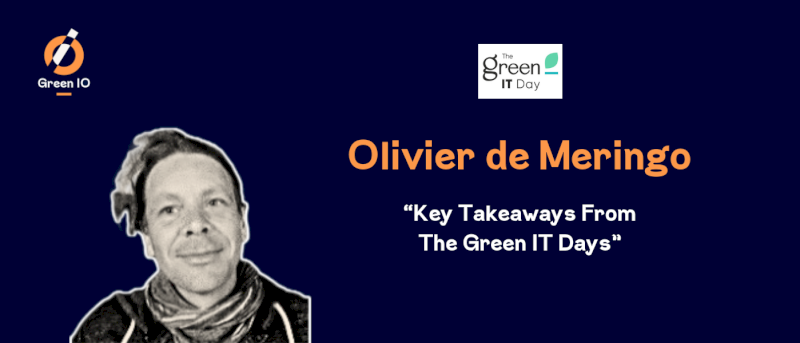Articles
Key Takeaways From The Green IT Days with Olivier de Meringo

Wrap Up Article
I was delighted to attend the Green IT day(s) conference which took place in Montpellier and Toulouse (south of France) on October 2 and 3.
This year's theme was "Digital and life, virus or vivus ?" It was a great opportunity to explore both the positive and negative impacts of digital on our ability to live on our small planet.
Compared to previous editions, we felt a revealing shift towards anti-greenwashing positions over the years, and many topics were related to AI adoption. Specifically, the talk given last year by David Maenda Kithoko, was cited multiple times. Its strong testimony of the socio-ecological impacts of mining in Central Africa left nobody indifferent.
There were numerous conferences, panels, and impromptu encounters, but some powerful key points include:
# We will have to choose where to apply the digital resources.
Michel Robert gave the keynote, and presented ADASTRA, one of the most energy efficient supercomputers dedicated to public research. It was a great way to give us orders of magnitude in terms of computing power, energy consumption, and the infrastructure already in place to support public GenAI adoption, where forecasts of evolving energy consumption for such infrastructure clearly point to forthcoming shortages. In other words, the projected speed of adoption and evolution of usage is not compatible with the structural delays needed to provide additional sources of power.
This quickly leads to the question of purpose.Although research and science clearly benefit from technical evolution, both the speaker and the audience questioned the purpose of on-tap Gen AI systems, and so the idea of AI for common good seemed central in the debate.
# The need for a Digital de-escalation
Olivier Lefebvre and Marilyne Barisic took the time to remind us that we need to consider the social environment in which digitalisation happens. It is a complex subject, because it intersects a kind of rationale (an economical approach of innovation) intersects with ideology ("we connect people") that results in transforming a user’s way of life.
In another panel, university professors and educators discussed the questionable impacts of seeing their students rely on GenAI to perform at exams, but raised strong doubts about the long term consequences of their long term ability to learn, although the subject is still very controversial among professors.
These considerations put in light the need to consider ethics or responsibility, not only at an individual level, but rather combine individual responses (e.g. awareness sessions and self regulation) with systemic interventions (e.g. regulations). It could also mean enforcing the right to a non digital access to services..
# Where digital and IA bring benefits
Several examples of virtuous uses of digital solutions were also presented, often in the context of providing data to help publicly operated service decision making. Projects were related to cartography of geographical area (land use, coastal erosion, identifying water reserves), marine preservation (using IA to detect fishing patterns), or predicting leakages in water networks.
# Digital for green, myth or reality ?
Can digital contribute to reducing national carbon footprints in different industrial sectors ?
To address this complex question, Gilo Malpart presented the methodology behind the IT4Green study. This robust (yet to be published) study, involving several experts coordinated by ADEME (the French Agency for Ecological Transition), will give us a first set of results corresponding to a multi-criteria lifecycle analysis of IT4Green projects. The 5 first use cases have been evaluated through a consequential LCA methodology in order to account for direct and indirect effects of digital in representative sectors. A second set of use cases is expected for Q1 2026.
It must be highlighted that the first step in this study already provides us with a very complete, state of the art corpus of scientific knowledge on the environmental effects of digitalisation and methods to access impacts: https://librairie.ademe.fr/economie-circulaire-et-dechets/7785-evaluation-environnementale-des-effets-directs-et-indirects-du-numerique-pour-des-cas-d-usage.html#product-features
The second interim report describes the methodology to select use cases and identify their major impact factors: https://librairie.ademe.fr/economie-circulaire-et-dechets/8073-environmental-assessment-of-the-direct-and-indirect-effects-of-digital-technology-on-use-cases.html
These reports are well worth a read, at least to tame our impatience until the publication of the complete results, and I am already sure that this will bring some not-so-intuitive discoveries that will spark lively exchanges at Green IO Paris.
Join +2000 responsible readers

Green IO newsletter
Once a month, carefully curated news on digital sustainability and Green IO contents delivered in your mailbox